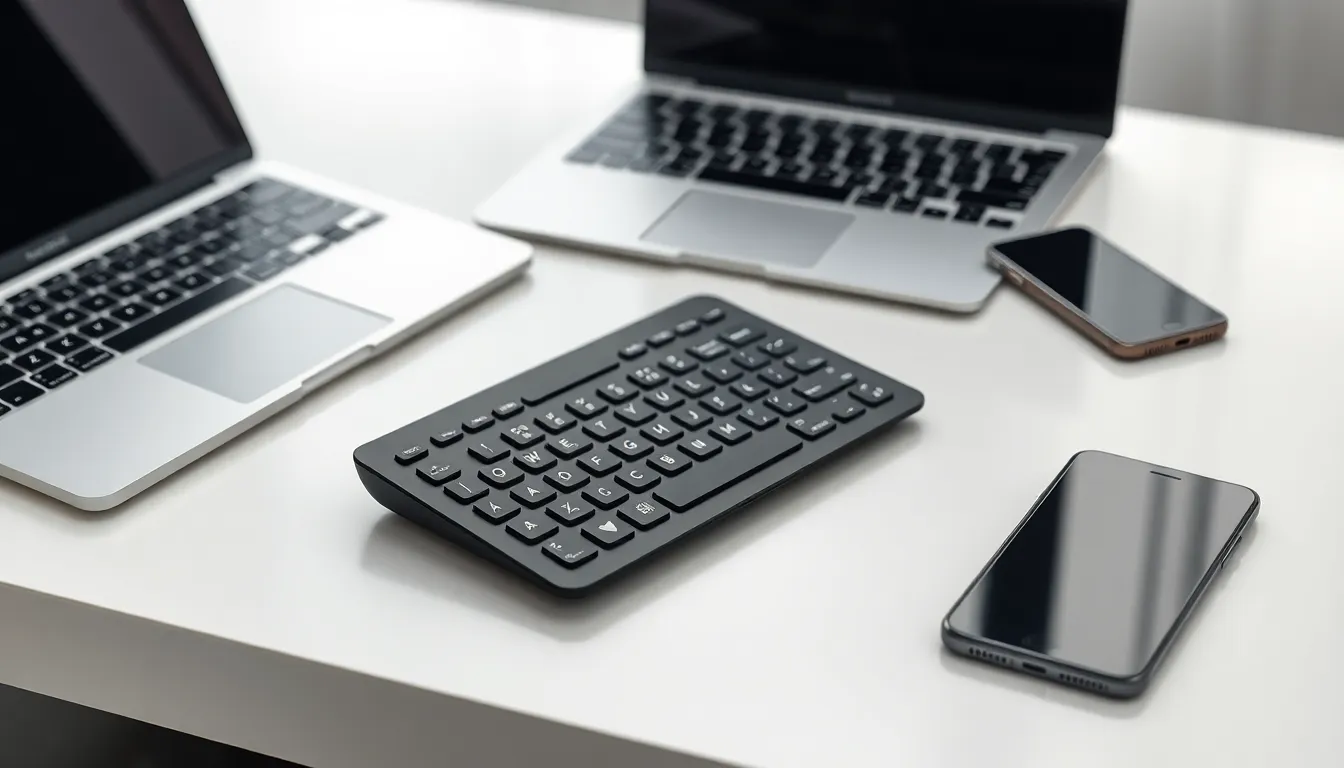Table of Contents
ToggleIn a world where every inch of desk space counts, the palm-sized keyboard is a game changer. Imagine typing away on a device small enough to fit in your pocket yet powerful enough to rival its full-sized counterparts. It’s like having a mini assistant that doesn’t take up any room—perfect for those who want to declutter their workspace without sacrificing productivity.
Overview of Palm-Sized Keyboards
Palm-sized keyboards offer a unique blend of portability and functionality. Designed to fit snugly in a pocket, these keyboards deliver a typing experience akin to that of traditional full-sized models. Compactness addresses the demand for minimizing desk space, particularly in crowded environments.
Users appreciate the lightweight nature of these devices. Weighing typically under a pound, palm-sized keyboards remain unobtrusive for on-the-go use. Various configurations exist, from standard layouts to more specialized designs, catering to different typing preferences.
Durability adds to their appeal. Many palm-sized keyboards feature robust materials that withstand everyday wear and tear. Resistance to spills and drops enhances their suitability for travel. Unlike bulky alternatives, the streamlined design facilitates ease of transport.
Connectivity options further enhance usability. Most keyboards integrate Bluetooth technology, allowing seamless connections to tablets, smartphones, and laptops. Recharging capabilities prove essential as well, with many offering extended battery life from a single charge.
Regarding audience, professionals and students find these keyboards particularly beneficial. Remote workers rely on compact devices to maintain productivity while traveling. Gamers also benefit from the quick response times and customizable keys found in various models.
Affordability remains vital in the purchasing decision. A variety of price points exist within the market, enabling consumers to choose devices that suit their budget without sacrificing quality. With numerous features available, users enjoy the flexibility to select keyboards that best meet their needs.
Key Features of Palm-Sized Keyboards
Palm-sized keyboards stand out for their unique combination of portability and functionality. Users can easily carry them in pockets or small bags, making them perfect for on-the-go scenarios.
Portability and Design
Portability defines palm-sized keyboards. Their compact design fits effortlessly into small spaces, allowing for easy transportation. Lightweight materials contribute to their overall convenience, as users can carry these devices without added bulk. Many models feature an ergonomic layout, ensuring comfortable typing even during extended use. Also, robust construction materials help resist spills and drops, enhancing durability for frequent travelers. A sleek appearance complements their functionality, making them attractive options for professionals and students alike.
Compatibility Options
Compatibility options play a crucial role in the usability of palm-sized keyboards. Most models utilize Bluetooth technology, allowing seamless pairing with various devices, including tablets, smartphones, and laptops. Additionally, many keyboards support multiple operating systems, such as Windows, macOS, iOS, and Android. This flexibility enables users to switch between devices without hassle. Some keyboards include USB receivers, providing wired connectivity for environments where Bluetooth isn’t feasible. Enhanced compatibility ensures that users can integrate easily into their work setups, enhancing productivity across different platforms.
Performance Analysis
Performance of palm-sized keyboards excels in both typing experience and connectivity solutions, offering users reliable functionality in a compact format.
Typing Experience
Typing experience on palm-sized keyboards remains surprisingly comfortable. They feature ergonomic designs that reduce strain during prolonged use. Users notice how travel distance for keys resembles full-sized counterparts, ensuring quick, responsive input. Various layouts accommodate different typing habits, catering to both casual and professional needs. Many models incorporate tactile feedback, enhancing the overall typing quality and preventing errors. Noise levels also matter; quieter options provide discretion in shared spaces. Adjustments in key spacing allow for personal preferences, making this typing experience tailored to individual users.
Connectivity Solutions
Connectivity solutions for palm-sized keyboards prove versatile and efficient. Most models utilize Bluetooth technology, enabling connections to multiple devices like tablets, smartphones, and laptops. Users enjoy seamless switching between devices without the hassle of re-pairing. Wired alternatives often feature USB receivers, ensuring reliable performance in environments lacking Bluetooth support. Compatibility with different operating systems, including Windows, macOS, and Android, further enhances user experience. Some keyboards support pairing with several devices simultaneously, delivering convenience for multitaskers. Overall, these connectivity options maintain flexibility, catering to diverse user needs in various settings.
Pros and Cons of Using Palm-Sized Keyboards
Palm-sized keyboards offer distinct advantages. Their compact design enhances portability, making them easy to carry in a pocket or bag. Users often appreciate the functionality they provide, resembling full-sized keyboards without the bulk. Ergonomic layouts contribute to a comfortable typing experience, even during extended sessions. Many models incorporate durability features, like spill resistance, appealing to those who travel frequently.
Despite these strengths, drawbacks exist. Some individuals find the smaller key sizes challenging, impacting typing speed and accuracy. Limited space might feel cramped for users accustomed to larger keyboards. Battery life can vary, with some models requiring frequent recharges. Various connectivity options, while generally beneficial, may create complications in certain environments. Bluetooth connections, though convenient, sometimes experience latency, affecting performance during critical tasks.
Examining these factors helps users recognize what works best for them. Working in tight spaces may favor the compact design of palm-sized keyboards. Conversely, individuals prioritizing typing speed might prefer traditional options for their ample key spacing. Versatile connectivity options frequently enable pairing with multiple devices, enhancing flexibility. The final decision often hinges on personal needs and work habits, along with the specific environments where keyboards are used.
Users who frequently switch between devices will value palm-sized keyboards for their compatibility. Professionals and students alike benefit from the tactile feedback offered by many models, contributing to an overall enjoyable typing experience. The balance of pros and cons ultimately shapes the landscape of palm-sized keyboard usage, catering to a range of preferences.
Conclusion
Palm-sized keyboards represent a significant advancement in portable technology. They blend convenience with functionality, making them perfect for those who need to work efficiently in tight spaces. With their ergonomic designs and robust materials, these keyboards cater to a variety of users, from professionals to students.
Their ability to connect seamlessly to multiple devices enhances productivity and flexibility. While some may find the smaller key sizes a challenge, the benefits often outweigh the drawbacks. As remote work and mobile computing continue to rise, palm-sized keyboards are likely to become a staple for anyone seeking an efficient and stylish typing solution.








